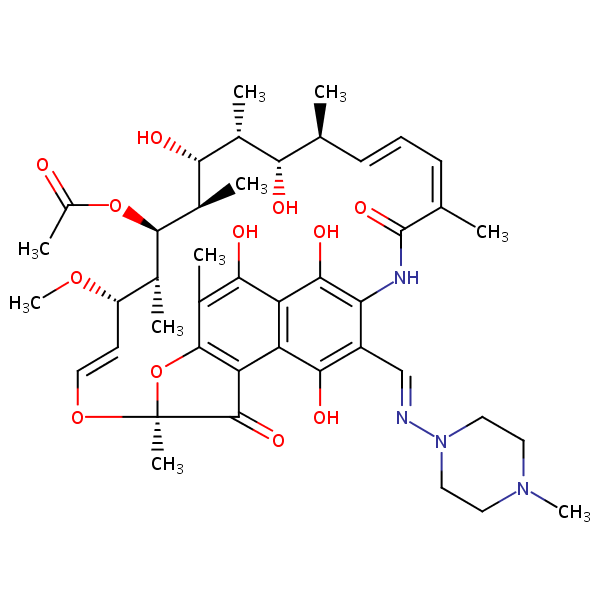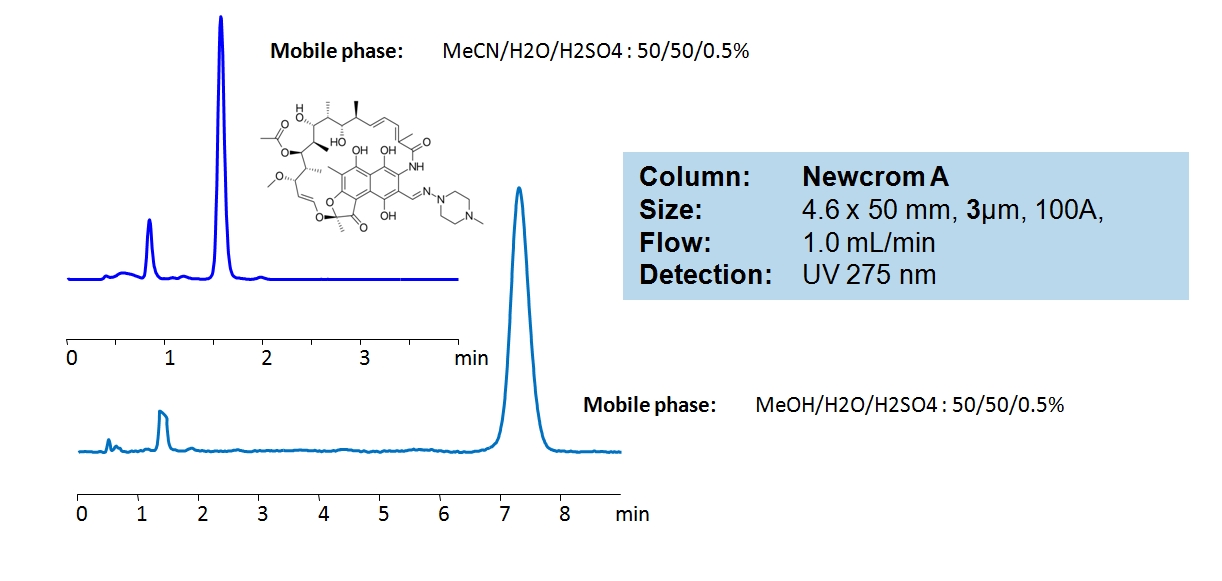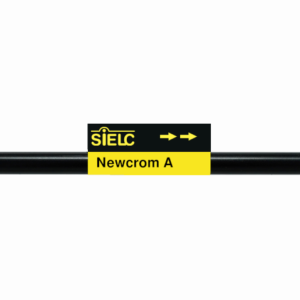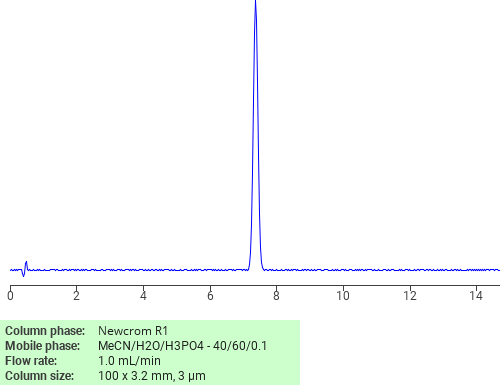| CAS Number | 13292-46-1 |
|---|---|
| Molecular Formula | C43H58N4O12 |
| Molecular Weight | 822.954 |
| InChI Key | JQXXHWHPUNPDRT-WLSIYKJHSA-N |
| LogP | 2.91 |
| Synonyms |
|
Applications:
HPLC – MS Method for Analysis of Rifampicin and Oxidation product on Primesep 100 Column
October 2, 2023
HPLC Method for Analysis of Rifampicin on Primesep 100 by SIELC Technologies
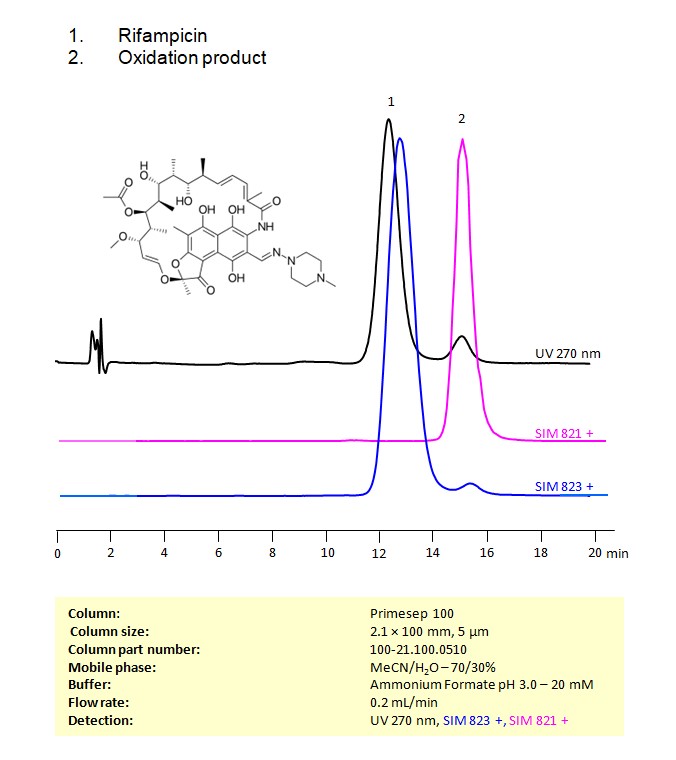
High Performance Liquid Chromatography (HPLC) Method for Analysis of Rifampicin
Rifampicin is an important antibiotic used primarily in the treatment of tuberculosis. Let’s delve into both rifampicin and its metabolite, rifampicin quinone:
Rifampicin:
Mechanism of Action: Rifampicin inhibits bacterial DNA-dependent RNA polymerase, thereby preventing RNA synthesis and subsequent protein synthesis.
Uses: It’s mainly used for the treatment of tuberculosis, often in combination with other antitubercular agents. It can also be used to treat leprosy, and as prophylaxis for Neisseria meningitidis (meningococcal) infections.
Rifampicin can be retained, separated and analyzed on a Primesep 100 mixed-mode stationary phase column using an isocratic analytical method with a simple mobile phase of water, Acetonitrile (MeCN), and a ammonium format as a buffer. This analysis method can be detected using UV at 270 nm, an Evaporative Light Scattering Detector (ELSD), or any other evaporative detection method (CAD, ESI-MS)
| Column | Primesep 100, 2.1 x 100 mm, 5 µm, 100 A, dual ended |
| Mobile Phase | MeCN – 70%, |
| Buffer | Ammonium Formate pH 3.0-20 mM |
| Flow Rate | 0.2 ml/min |
| Detection | UV, 270 nm, SIM 823 +, SIM 821 + |
| Spray Voltage: | 1.5 kV |
| Nebulizing gas: | 1.5 L/min |
| Drying gas: | 15 L/min |
| DL temp: | 250 ˚C |
| Heat Block: | 400 ˚C |
| Class of Compounds | Drug, antibyotics |
| Analyzing Compounds | Rifampicin |
Application Column
Primesep 100
Column Diameter: 2.1 mm
Column Length: 100 mm
Particle Size: 5 µm
Pore Size: 100 A
Column options: dual ended

HPLC Determination of Rifampicin on Newcrom A column
May 4, 2020
HPLC Method for Rifampicin on Newcrom A by SIELC Technologies
High Performance Liquid Chromatography (HPLC) Method for Analysis of Rifampicin.
Rifampicin is an antibiotic used alongside other antibiotics to treat several types of bacterial infections like tuberculosis and Legionnaires’ disease. It works by inhibiting the bacteria’s RNA production and is on the World Health Organisation’s (WHO) List of essential medicines. It’s chemical formula is C43H58N4O12.
It can be retained in HPLC on Newcrom A mixed-mode column. The retention characteristics can be controlled by the organic modifier used in the mobile phase, with methanol (MeOH) having a longer retention time in comparison to acetonitrile (ACN). UV detection at 275nm.
| Column | Newcrom A, 4.6 x 50 mm, 3 µm, 100 A, dual ended |
| Mobile Phase | MeOH, MeCN |
| Buffer | H2SO4 – 0.5% |
| Flow Rate | 1.0 ml/min |
| Detection | UV 275 nm |
| Class of Compounds | Hydrophobic, Drugs, Antibiotics |
| Analyzing Compounds | Rifampicin |
Application Column
Newcrom A
Column Diameter: 4.6 mm
Column Length: 50 mm
Particle Size: 3 µm
Pore Size: 100 A
Column options: dual ended

Separation of Rifampicin on Newcrom R1 HPLC column
February 16, 2018
Rifampicin can be analyzed by this reverse phase (RP) HPLC method with simple conditions. The mobile phase contains an acetonitrile (MeCN), water, and phosphoric acid. For Mass-Spec (MS) compatible applications the phosphoric acid needs to be replaced with formic acid. Smaller 3 µm particles columns available for fast UPLC applications. This liquid chromatography method is scalable and can be used for isolation impurities in preparative separation. It also suitable for pharmacokinetics.
Application Column
Newcrom R1
The Newcrom columns are a family of reverse-phase-based columns. Newcrom A, AH, B, and BH are all mixed-mode columns with either positive or negative ion-pairing groups attached to either short (25 Å) or long (100 Å) ligand chains. Newcrom R1 is a special reverse-phase column with low silanol activity.
Select options